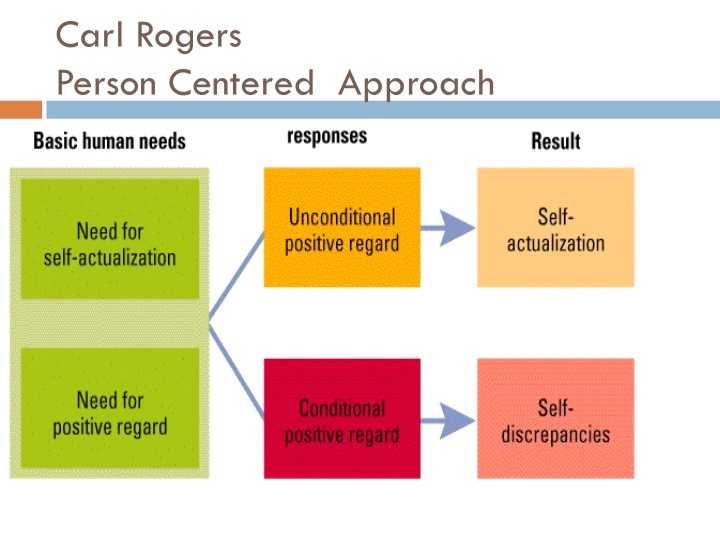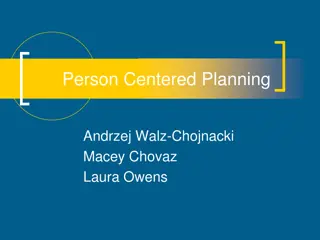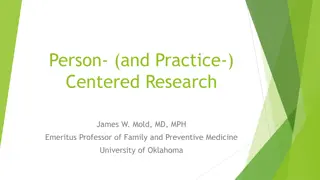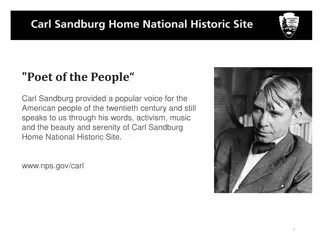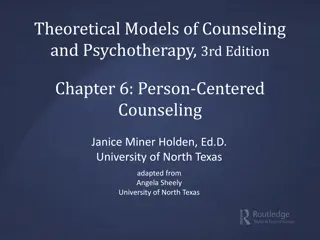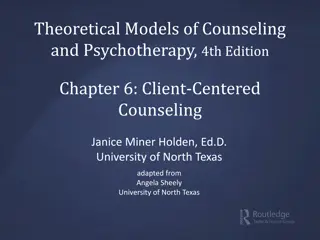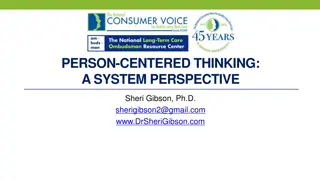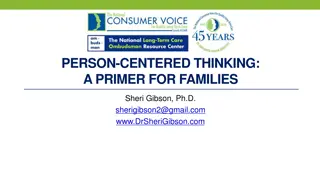Carl Rogers Person Centered Approach
Carl Rogers, a key figure in humanistic psychology, introduced the Person-Centered Approach focused on promoting self-actualization. His philosophy emphasizes trustworthiness, self-concept alignment, and nonjudgmental client-therapist relationships. Rogers' work extended beyond therapy into politics, aiming to reduce tensions and foster world peace. Explore his life, beliefs, and lasting impact in the field of psychology.
Download Presentation

Please find below an Image/Link to download the presentation.
The content on the website is provided AS IS for your information and personal use only. It may not be sold, licensed, or shared on other websites without obtaining consent from the author.If you encounter any issues during the download, it is possible that the publisher has removed the file from their server.
You are allowed to download the files provided on this website for personal or commercial use, subject to the condition that they are used lawfully. All files are the property of their respective owners.
The content on the website is provided AS IS for your information and personal use only. It may not be sold, licensed, or shared on other websites without obtaining consent from the author.
E N D
Presentation Transcript
Carl Rogers Person Centered Approach
Carl Rogers 1902-1987 Family characterised by close and warm relationships Play was discouraged Scholarly interests than social interest Agriculture, history, religion and to clinical psychology In 1964 western Behavioural Sciences Institute in California- Fostered encountered groups In 1968- Centre for the studies of the person Mother & Theory of Nonjudgmental listening and acceptance if clients are to change Humanistic movement all over the world
CR During his last 15 years , he applied his person centred approach to politics by training policy makers, leaders and groups in conflict Greatest passion was to reduce interracial tensions and the effort to achieve world peace , he was nominated for the Nobel Peace Prize shortly before he died. After a fall in 1987, fracture in the hip, surgery, heart failure and his boots on as he hoped always looking forward I do not know when I will die , but I do know that I will have lived a full and exciting 85 years (1987, p.152).
Cr Therapist, author and the person were the same man He embodied the characteristics of the fully functioning person and challenge the status quo through out his career For a person to achieve self-actualization they must be in a state of congruence. According to Rogers, we want to feel, experience and behave in ways which are consistent with our self-image and which reflect what we would like to be like, our ideal-self
Human Nature Based on a philosophy of human nature that postulates an inner striving for self actualization. View is phenomenological ( We structure ourselves according to our perceptions of reality. We are motivated to actualize ourselves in the reality that we perceive ) People are essentially trustworthy Potential for understanding themselves and resolving problems without direct intervention on the therapist s part Attitude and qualities of the therapist and the quality of client/therapist relationships as the prime determinants of the therapy
Self Perceived/Real/Ideal Self-concept emerges as a pivotal product of the process. As individuals strive toward actualization, the self is divided into two categories: the real self and the ideal self. The real self is representative of the individual while the ideal self exemplifies the aspirations of the individual. When the real self is closely aligned with the ideal self, there is a wholesome sense of congruence
Major turning points- Period 1 Zimring and Raskin 1- 1940s- Non directive counselling as opposed to psychoanalytic approach to individual counselling. He challenged the basic assumption that Counsellor knows the best Diagnostic procedures were inadequate Focussed on clarifying and reflecting the client s verbal messages Acceptance of feelings and getting insight in to these feelings
Period II 1950s Client-centred therapy was published to reflect on the client rather ND methods Phenomenological world of the client People behave from their own internal frame of reference Actualizing tendency as the motivational force to change Offer a facilitative climate where congruence, acceptance and empathy were present and the client perceived these conditions , therapeutic movements would occur
Period III 1960 s on becoming a person ( Rogers, 1961) Becoming the person that one truly is Openness to experience, internal locus of evaluation and willingness to be process Quality of relationships as a catalyst leading to personality change Student centred teaching , encounter groups
Period IV Person centred approach How people obtain, share and surrender power and control over themselves and others Broadening of the approach Individual and family, education, leadership and administration, organizational development, health care, international relations
Third Force Existentialism and Humanism Experiential and relationship oriented Existentialism and humanism ( Confusing) Common concepts Freedom choice, values, personal responsibility, purpose and meaning Both approaches call for the therapist to enter client s subjective world Differences- Existentialism- we are faced with the anxiety of choosing to create and identity in a world that lacks intrinsic meaning Humanism talks about a natural potential that we can actualize and through which we can find meaning Humanistic how an acron in good conditions will become an oak Existentialism- No internal nature but faced with every choices of what to make of this condition When it is lived, it stimulates constructive changes in others
View of human nature Find the core of an individual when one finds a trustworthy, positive centre When therapists communicate their realness, caring and non-judgemental understanding, significant changes are in the client are most likely to occur No superior / expert opinion
Three attributes Congruence ( genuineness or realness) Unconditional positive regard ( acceptance and caring Accurate empathic understanding ( an ability to deeply grasp the subjective world of another person) Less defensive and more open Leave the doors open for self exploration When people are free they find their own way Maslow psychopathology of the average so called normals never extend themselves to become what they are capable of becoming Too much importance is given to medical models Too little attention is given to love , creativity, joy and peak expereinces Positive implication of moving towards psychological health from maladjustment Therapy is more than an adjustment to norms But living fully and authentically demands a struggle People never arrive at a static state of being self actualized, they continue in the process of actualizing themselves Focus on the here and now experience A shared journey , where both can be falliable
Therapeutic process Therapeutic goals Focus is not on the problems but person To provide a climate conducive to helping the individuals become a fully functioning person Help them to remove the masks Lost contact with the real self (Facades) In therapy: Encourage these characteristics 1. openness to experience 2. in themselves 3. sense of evaluation 4. Willingness to continue growing
Therapists Function and Role Attidues of the therapist rather than knowledge, theories, techniques facilitate personality change in the client Not to do something but ways of being Creating a helping relationship where clients experience freedom to explore the areas of their life either denied or distorted
Clients Experience Perception of their own experience in therapy and of the counsellor s attitudes When a client feels understood and accepted their defensiveness is less and they become more open They begin to appreciate more about themselves and their behaviours become creative and empowering
Relationship The following six conditions are necessary and sufficient for personality changes to occur 1. Two persons in psychological contact 2. First- Client- Experiences incongruence 3. Second Therapist- in congruence/Integrated 4.Therapist expereinces unconditional positive regard/ Caring/Acceptance 5. Empathic understaning is communicated 6. therapist s Uncondtional positive regard and Empathy is to a minimal degree achieved When they expereince realness of the therapist, they drop many of the pretenses and are real with both themselves and the therapist Therapist relationship tends to free the client from self defeating ways
Three personal qualities of the therapist Congruence or Genuineness : Real self/ ideal Self By expressing both negative and positive experiences, facilitate honest communications Feels one way about the client but acts in a different way Congruence works on a continuum
Unconditional Positive regard Caring is unconditional not contaminated by evaluation and judgements of the client s Feelings, thoughts and behaviours as good and bad It is not approval of all the overt behaviours I ll accept you as you are ( no conditions) Therapists caring be nonpossessive Greater the degree of caring, prizing, accepting and valuing, therapy will be successful
Accurate Empathic Understanding Therapist tries to perceive the subjective experience particularly in the here and now As if they were his own without being lost in those feelings Deep subjective experience of the client with. the client It is a sense of personal identification Therapist should not lose their own separatedness When the therpists grasps the client s priviate world as the client sees and feels it, constructive change can happen
Fully functioning Person Rogers also proposed a central concept of his theory in the "fully functioning person." A fully functioning person is authentic and self-aware, being in touch with his feelings, emotions, and desires. He has a high degree of satisfaction with life, leaning in favour of positive thoughts, spirituality, and intrinsic values Fully functioning person is well on the way to becoming self-actualized.
Fully functioning Person Rogers identified five characteristics of the fully functioning person: 1. Open to experience: both positive and negative emotions accepted. Negative feelings are not denied, but worked through (rather than resorting to ego defense mechanisms). 2. Existential living: in touch with different experiences as they occur in life, avoiding prejudging and preconceptions. Being able to live and fully appreciate the present, not always looking back to the past or forward to the future (i.e., living for the moment). 3. Trust feelings: feeling, instincts, and gut-reactions are paid attention to and trusted. People s own decisions are the right ones, and we should trust ourselves to make the right choices. 4. Creativity: creative thinking and risk-taking are features of a person s life. A person does not play safe all the time. This involves the ability to adjust and change and seek new experiences. 5. Fulfilled life: a person is happy and satisfied with life, and always looking for new challenges and experiences.
Evaluating Humanists Hard to operationally define many of the concepts. Have added balance to the study of personality. The approach has encouraged others to focus on positive psychology. The argument that we have the power to choose our own destiny has fostered a new appreciation for resilience.
